|
The Nature of Collecting Natural History
A Conversation With David Herskowitz,
Director of Natural History At Heritage Auction Galleries, Dallas, Texas
Posted April
2011
What does the collecting of Natural History items encompass?
David Herskowitz: Just about anything that is seen in a Natural History museum—gems, minerals, fossils, dinosauria, and paleo-artifacts.
Which Natural History specimens are the most popular right now?
DH: Two categories are big now: mineral specimens and dinosauria—their bones, teeth, and so on.
In your opinion, what is the crème de la crème of Natural History collectibles?
DH: The ultimate of Natural History specimens would be the saber-toothed tiger skull. There are perhaps 15 or less skulls in private collections now.
Heritage Galleries sold a skull last May. What did it go for?
DH: Saber-toothed tiger skulls only come up for market once every six years or so, which is why the one we sold went for $334,600. It was found in the Wilshire/Hauser Tar Pit across the street from the Rancho La Brea Tar Pit.
What other types of dinosaur fossils are rare or valuable?
DH: Another top collectible would be a T-rex skull. I have never sold one, but I have sold T-rex bones. Their teeth are more poplar than the teeth of other dinosaurs. Anything from a T-rex will maintain its value.
When it comes to dinosaurs, carnivores are the most popular. They definitely beat out the herbivores. Other examples are any fossils from the Tyrannosaurid family. Next would be the Raptor family of dinosaurs. Raptors are really popular because of Jurassic Park. It really highlighted them.
What should a buyer expect to pay for this type of fossil?
DH: Small T-rex bones sell for about $500, or they can go as low as $300 to $350 for a small tail vertebrate. A skull can sell for just over $1 million. A duck-billed dinosaur skull can go for as little as $30,000, but then, they were herbivores.
Have prices fallen for dinosauria because of the current economy?
DH: Prices haven’t fallen, but there aren’t as many buyers. The demand is steady, though, and prices are increasing. The last saber-tooth skull to sell before the one I sold last May went for $230,000 and the one before that for $190,000. When I first started in this business 15 years ago, a skull sold for $30,000. The reason why demand is steady is because, as you know, they aren’t making any more.
Demand began increasing a few years ago when people finally began to learn they could buy fossils. The most common question I have been asked at auctions is, “Can you really buy them [fossils]? People were just unaware that they could buy fossils, probably because they were used to seeing them only in museums. But with more Natural History auctions and the Internet, more collectors now realize they can own a piece of Earth history, and the more who know, the greater the demand.
Are there any restrictions on purchasing dinosaur fossils?
DH: There are restrictions if they are found on public land. You can’t collect on a lot of public land, like the Petrified Forest in Arizona since it is state land. But there are so many fossils on private lands, there is no reason to go collecting on public land.
If you were contacted by an individual who had a fossil to sell, like the fossil of a complete dinosaur, how would you proceed?
DH: If someone has a fossil in their collection and it is prepped and mounted, I would evaluate who excavated it, where it was excavated, and how the preparation was done. Then I would discuss with the owner how to proceed to auction it.
For those still in the ground, it is a different story. A while back, I received a call from a person who had found a mosasaur, which is a carnivorous marine reptile that was common throughout Texas. North Texas was under water at one time, and a lot of marine animals are found there. In cases like this, I would contact a professional paleontologist, who would investigate the fossil. If it turns out to be a real dinosaur fossil, they would excavate it, clean it, mount it, and then they and the discoverer would share the profit when it is sold.
I get calls all the time from people who say they have found dinosaur bones, and it turns out to be a mammal, like a dog bone.
Meteorites are another Natural History collectible that infatuates people. How do you value them?
DH: A lot of factors are involved in evaluating a meteor. There is a big diversity in meteors because they are made up of so many different elements. The most common type is nickel-iron; they have been discovered all around the world.
The Gibeon meteorite is high on the food chain for collectors because of its high nickel content. This makes it stable so it doesn’t rust like meteorites high in iron. The Gibeon meteorite hit Namibia in southeast Africa during pre-historic times. It exploded in the atmosphere, and chunks landed over a couple of hundred miles.
Gibeon meteorites have an attractive crystalline pattern that, when sliced and acid etched, are very beautiful. Aesthetics are an important factor in valuing a meteor. Some iron meteorites look like a big lump of coal; others are very sculptural in appearance.
The quantity found of a meteorite also affects the value. With the Gibeon meteorite, probably ten tons have been recovered. When a meteorite comes to earth, it breaks up or explodes in the atmosphere. If a large quantity is found, the value is less. If only a few specimens are found, that adds to the value.
Value also depends on where it lands. If a meteor is found in a cornfield in Kansas, it is not as valuable as one found in Los Angeles County. Also when it hits a smaller target, like a small island in the Philippines, the same meteorite is worth more.
One factor makes a meteor very valuable—the presence of olivine crystals. Olivine is a common mineral on Earth, but when it has peridot crystals in it, it is a gem—a gem from outer space. Meteors with olivine and peridot crystals are categorized as pallasites.
Sometimes when a pallasite impacts, many of the crystals are shocked, or cracked, and have lines running through them. Pallasites that are less shocked are more transparent after they are sliced so you can see through the crystal, and they are more valuable.
Pallasites make up a very small part of the total amount of meteorites; less than .01% is pallasite. They sell for, depending on the size, from $10/gram to $40/gram. Of course, the more attractive they are, the more valuable. As a contrast, in 1995 Gibeon (non-pallasite) meteorites sold for $7.50 per pound. Now, they sell for $200 per pound. With about 453.6 grams to the pound, a pallasite sells today for approximately $4,536 to $18,144 for a pound (or $283 to $1,134 per ounce).
The biggest leap in prices for meteorites came between 1995 and 2001. Prices really jumped, and they have been steadily rising. The supply is not getting much bigger. Last year, the price of meteorites maintained value, despite the economy.
Another class of meteors is even more valuable—those that originate from planetary bodies like Mars or the Moon. Most meteors are from the Asteroid Belt. Asteroids are moving in different directions so they bump into each other and go flying out of orbit and land here. Meteors from the Moon or Mars are caused by large meteors impacting on their surfaces and chunks getting blown out into space. Sometimes, they get caught in our gravitational field and land on Earth.
I have sold one gram of a Moon rock for $19,000.
Just as an aside, each of the four Apollo Missions brought back less than 200 pounds of rocks, and virtually none of it is available to the public. They are all controlled by Smithsonian.
How is the provenance of a meteorite proven?
DH: Laboratories and museums test them. If you have one, take it to an institution like the Lunar and Planetary Laboratory in Tucson. They take 20% of it to test and classify it and to store as a record.
What is the state now of fakes and reproductions in Natural History collectibles?
DH: Most meteorites contain the same elements as found on Earth. However, you can’t mix nickel and iron on Earth and pass it off as a meteor because the structure is different. Meteorites from asteroids are formed in zero gravity, so their structure is different from that of metals and other elements formed on Earth.
On Earth, iron pyrite is in a cubic or octahedron form. In space, the crystals grow in all different directions. That’s how they determine if it came from a planetary body or the Asteroid Belt.
How would a collector find an expert to verify the authenticity of a natural history object?
DH: Contact a local university that has a geology department or a paleontology department.
What do you foresee in the future for Natural History collectibles?
DH: Top specimens, fine specimens are always going to do well; they will always increase in value, like the . The same thing with certain pristine dinosaur bones—when they are beautifully prepared and mounted, they will at least hold their value.
The average fossil, like fossil leaves or shells, won’t increase in value much. At one time, only 20% of the Earth was land mass. Oceans practically covered the Earth, so marine creatures aren’t rare. Fossils of land animals like dinosaurs and mammals and fossil footprints are extremely rare.
With meteors, you never know when there will be a shower, and then when there is one, you never know how much will be recovered. About February of 2009, a meteor landed outside Dallas. A big fireball was caught by a news crew that happened to be covering a marathon. Just about every meteor hunter descended on West Texas; what they recovered wouldn’t fill a shoe box. That meteor is constantly increasing in value, from $1 per gram, then $3, then $5 within a few months.
___________________________________
Our appreciation to David Herskowitz for this interview. He can be contacted at Heritage Auction Galleries at 214-528-3500 or DavidH@HA.com.
|
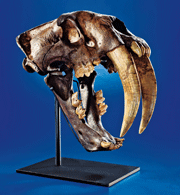
The skull from the Wilshire Hauser Pit, possibly 12,000-20,000 years old; the finest specimen to appear on the open market; one of the top 10 in the world. The cranium and lower jaws are not composite, but are from the same animal, which is extremely rare. All teeth are original. Length: 12.75 inches; saber teeth measure 7 5/8 inches. Sold for $334,600 with bp.
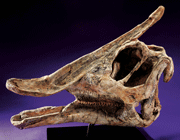
The crested and duck-billed skull of a Saurolophus, an herbivore the size of a bus. Barely more than 10 skulls are known, and only one complete skeleton has ever been found. All teeth are intact and original. Height: 26.5 inches long, 21.75 inches tall. Sold for $38,240 with bp.
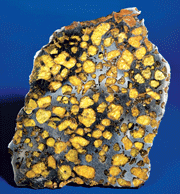
A complete slice of the Imilac pallasite originating from the mantle-core boundary of a planetary body that broke apart during the formation of the solar system. The olivine and peridot crystals seen here are the most resplendent gems on Earth from outer space. Size: 5.6 x 3.5 x .01 inches; weight: 70.1 grams; sold for $1,912, including buyer’s premium. (All items sold by and photos courtesy of Heritage Auctions.)
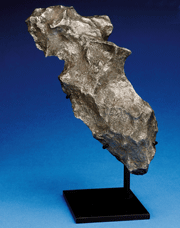
Meteorites do not typically look like this thunderbolt-like example. This 45,000-year-old meteorite was part of the asteroid that hit the Arizona desert with the force of 100+ atomic bombs, ejecting fragments 11+ miles away, and creating the Meteor Crater near Winslow, Az. This Canyon Diablo meteorite measures 9.5 x 3 x 4.25 inches and weighs 6.5 lbs. It sold for $2,987 including bp.
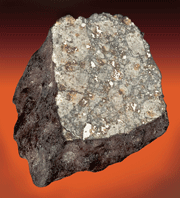
A small end piece of the West, Texas, meteorite shower, cut and polished, 1.25 x .9 x .5 inches. Articulated lines of impact melt resulted from a collision in outer space with another mass at a cosmic velocity of at least 10 miles per second. Sold for $478.
|